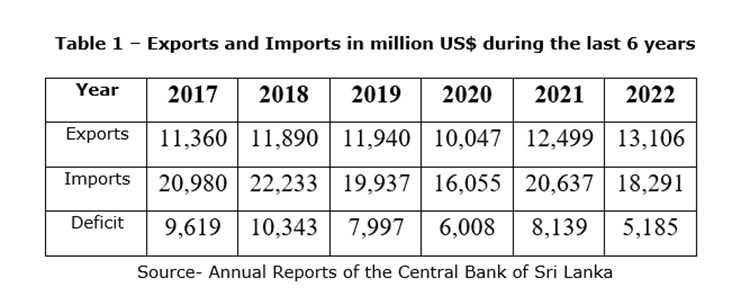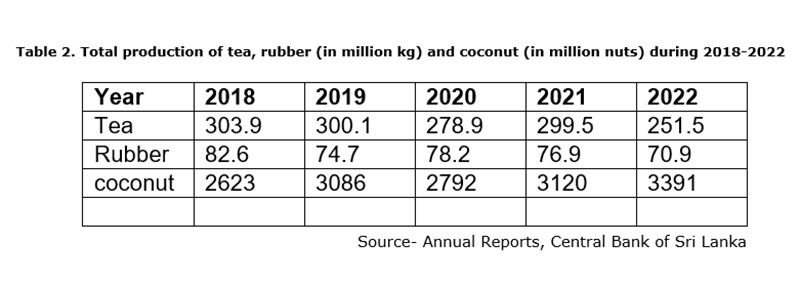Reducing Trade Deficit
Posted on February 16th, 2024
By DR. C. S. WEERARATNA Courtesy The Island

A trade deficit typically occurs when a country does not produce enough goods for its citizens. When production cannot meet demand as in Sri Lanka, there is a need to import thereby widening the trade deficit. A persistent trade deficit is detrimental to a country’s economy because it is financed with debt. The trade deficit in Sri Lanka had been persistent over a long period of time (Table 1)

Persistent Trade Deficit tends to have a negative impact on employment, growth, and value of the currency. If we are to reduce the trade deficit it is essential that exports are increased and imports are reduced as much as possible.
Increase export earnings
The dire need to increase our export earnings to meet the severe financial crisis we are facing today has been emphasised by many. As indicated in Table 1, exports during the last six years (this is the case even in earlier years) have not increased by any substantial amount in spite of an Export Development Board and numerous other related authorities. Increasing exports is of paramount importance to improve our economy. It is because of the importance of increasing exports that the government brought a National Export Strategy. But what are we going to export?
Plantation Sector
Our major exports are plantation crops, tea, rubber and coconut. Around 800,000 ha are cultivated with plantation crops. However, as indicated in Table 2, the production of these major export crops does not show any substantial increase during the last five years.
As shown in Table 2, tea production has been fluctuating around 275 million kg per year during the last few years. Annual rubber production shows a tendency to decrease. Coconut production has fluctuated around 300 million nuts per year. This appalling situation in the plantation sector can be attributed to many factors, but the Ministry of Plantation Industries and the relevant authorities appear to have not taken effective strategies to remedy this situation. If the productivity of this sector is raised, it would be possible to increase foreign exchange earnings thereby reducing the trade deficit. It is necessary that the relevant authorities take appropriate action to increase the production of the plantation crops.
A large number of crops other than tea, rubber and coconut cultivated in Sri Lanka have a high potential as export crops. There are 24 agro-ecological zones, each characterised by specific climate and soil. This makes it possible to cultivate different types of crops. Among these are spice crops such as cinnamon, pepper and nutmeg, tuberous crops, horticultural and floricultural crops, medicinal herbs etc. which have a considerable export potential. In 2020, spice crops earned around US $ 400 million. There are many organizations such as the Ministries of Agriculture, Industry and Commerce, Export Development Board, Industrial Development Board etc. but, there appears to be no proper plan to increase the production of these crops.
Out of the 6.5 million hectares of land, around 2.0 million hectares are in the Wet Zone. About 75% of it is cultivated and most of this land is of low-productivity mainly due to soil degradation. In the Dry Zone, out of the 4.5 million hectares only about 2 million hectares are in productive use. Thus, there is a large extent of potentially cultivable land in the Dry Zone. Most of the soils in the Dry Zone are relatively more fertile than those in the Wet Zone. Non-availability of adequate rainfall during the Yala season is one of the limiting factors of crop production in the Dry Zone. However, better water management practices would reduce this limitation. Also, various major irrigation projects such as Mahaveli, Kirindi Oya, Muthukandiya and Inginimitiya provide irrigation to about 200,000 hectares in the Dry Zone. The recently inaugurated Moraghakanda project is expected to provide irrigation water to nearly 80,000 ha. The numerous minor irrigation projects too would increase the irrigable area in the Dry Zone. Thus, there is a considerable potential to increase the level of crop production in Sri Lanka, export of which would enable to increase exports and reduce trade deficit.
Agro-Industries:
Promoting industries based on agriculture (agro-industries) will have a considerable positive impact on increasing export earnings thereby reducing trade deficit. There is an urgent need to develop agro-industries in Sri Lanka, which will have a tremendous positive impact on employment and rural poverty. A large number of crops cultivated in Sri Lanka, including rice, have a considerable potential in various agro-industries. However, only rubber, coconut and a few fruit crops are used in industries. Crops such as cassava, horticultural and floricultural crops, medicinal herbs, cane, bamboo, sunflower, castor, ayurvedic herbs such as katuwelbatu , etc. have a considerable potential as export crops, but are not cultivated to any appreciable extent for want of better and improved varieties, technological know-how, relevant market information etc. Development of agro-industries will also increase export income and will have a tremendous positive impact on the economy of the country, and also provide employment opportunities among rural people. Private sector can be involved in such projects for which appropriate technical assistance needs to be given by the relevant public organisations. However, there appears to be no proper long-term plan to develop agro-industries, except for some ad-hoc projects. The Ministries of Industries and Agriculture should implement an effective Agro-Industrial Development Programme, in collaboration with the private sector, which undoubtedly would improve export income, employment opportunities and incomes in the rural areas.

Small and Medium-Term Industries
Products of crop based Small and Medium Enterprises (SMEs), have a high export potential and play a very important role in economic development of Sri Lanka because they have the capacity to achieve rapid economic growth, while generating a considerable extent of employment opportunities. Promotion of SMEs would result in increasing industrial output of the country, leading to more exports. However, not much emphasis appears to have been placed on improving SMEs, except providing loans from banks. A main factor which limits the SME sector is inadequate raw materials.
Increasing cost of Imports
While some talk about strategies to increase exports, there appears to be not much emphasis on reducing crop-based imports, which will have an appreciable impact on reducing trade deficit. Our import costs are likely to increase due to escalation of freight costs as a result of Houthi attacks in the red sea. This will widen our trade deficit.
Most of the food imported such as sugar, milk food, lentils, onion, maize, etc., which involves around US$ 2,000 million annually, can be locally produced, thereby reducing expenditure on food imports. For example, nearly 16% of food imports is spent on importing sugar, most of which can be locally produced. Sugar production in the country has not increased by any appreciable amounts during the present decade in spite of three sugar companies, Pelwatta, Sevanagala and Hingurana and the Sugarcane Research Institute. Kantale sugar factory remains closed over a long period, while a plan to cultivate sugarcane in Bibile remains shelved. There are crops such as coconut, kitul and palmyrah which can be used to manufacture sugar-based substances such as jaggery and treacle, but there appears to be no effective strategy to promote the production of these crops.
With regard to milk production we have around 1 million cattle consisting of mostly indigenous breeds. Their productivity is low (1-3 litres/day) mainly due to the poor nature of the breeds and inadequate low-quality feed supply. As a result, annually we import nearly 300 million US dollars worth of milk and other dairy products. There appears to be no effective plan to increase local milk production by improving the local breeds and supply of cattle feed. The dairy industry has a potential to contribute considerably to Sri Lanka’s economic development. But, instead of implementing an effective viable plan to develop the dairy industry in the country, the government imported around 20,000 cattle from New Zealand and Australia involving USD 73 million. Importing cattle to improve the dairy industry in the country is a futile action, as importing cattle alone is not going to increase milk production in the long run, unless there is an effective programme to upgrade local cattle breeds, promote cultivation of improved pasture grasses which can be grown under coconut and provide better veterinary practices.
Nearly 300 million US dollars worth of rice (a carbohydrate) is imported annually when there are many tuberous crops such as innala, sweet potato, yams which can replace a part of the rice we import thereby reducing expenditure on imports.
Eppawala Apatite (EA), which was discovered a few decades ago still remains partly underutilized. EA can be used to manufacture phosphate fertilisers. But still we grind the rock and use the ground apatite as a P fertiliser, while spending millions to import Single Superphosphate and Triple Super Phosphate, which can be manufactured from EA.
The expenditure on subsidiary crops such as chillies, green gram, ground nut, potato etc, is millions of US dollars. The average per hectare yields and the extent of these crops have not increased by any appreciable amount during the last decade. In fact, chili production has decreased during the last few years. In the recent past, a former Minister of Agricultural Development Chamal Rajapaksa, appointed an Advisory Panel to make proposals to develop the agricultural sector in the country so that there is a quantitative and qualitative increase in crop production at a lower cost with no damage to the environment. During the last few years numerous programmes such as AMA’, Waga Sangramaya and Govi Sevana” were implemented. All these activities/programmes, appear to have not made any appreciable positive impact on the agricultural sector of the country indicated by increasing expenditure on food.
Science and Technology.
Effective use of Science and Technology (S&T) would tend to reduce imports and increase exports. During the last two decades, effective use of Science and Technology (S&T) enabled most of the South and South East Asian countries to develop substantially. However, in Sri Lanka, in spite of a number of scientific organisations such as the National Science Foundation, National Institute of Fundamental Studies, National Research Council of Sri Lanka, National Science and Technology Commission, which use a considerable amount of scarce financial resources, S&T has been used to a relatively very little extent to decrease imports which will tend to reduce trade deficit thereby improving the economy of the country.
A primary objective of use of S&T in a developing country such as Sri Lanka must be to conduct appropriate studies on the critical issues and advise the authorities on relevant action to be taken. Science and Technology need to be used to utilise locally available resources. Conducting research alone will not lead to economic development, unless the technologies developed by research are commercialised. Organisations such as the Industrial Development Board, the Board of Investments etc. need to coordinate with the relevant scientific organisations to attract investments on commercialisation of proven technologies. Vidatha Centers have been established in many DS Divisions to commercialise S&T. Perhaps the Ministry of Technology and Research may indicate to what extent these Vidatha Centers have been effective in commercialising S&T.
In Sri Lanka, during the last two decades, perhaps a few hundreds of research studies, involving billions of rupees worth of scarce resources, have been conducted. Findings of these research projects were presented at numerous conferences, seminars etc. It is important that we utilise these research findings to find solutions to some of the pressing problems of the country. But there appears to be no effective system to achieve this. Instead, the authorities are concerned in conducting more and more seminars and symposia without any plan to effectively utilise the findings/conclusions.
The authorities concerned should discuss these issues and take appropriate action. There has been rhetoric on economic development during the last few years. It is meaningful and effective actions that are necessary.